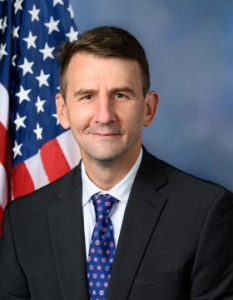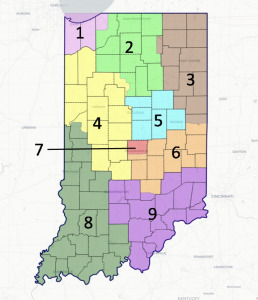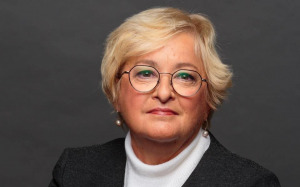Subscriber Benefit
As a subscriber you can listen to articles at work, in the car, or while you work out. Subscribe Now“Optically horrible.” A “hard no.” In “bad form.”
Hoosier leaders might be busy taking behind-the-scenes feedback on the prospect of early redistricting, but rank-and-file Republicans are increasingly going public with their opposition.
Statehouse lawmakers redraw districts after each decennial census. They last did so in 2021, and population data shows little change since then.
Indiana Democrats, meanwhile, are joining forces with their Texan counterparts to protest the move, just days after they led hundreds of Hoosiers in a rally to oppose early redistricting.

President Donald Trump is pushing Texas and other GOP-led states like Indiana to redistrict ahead of the 2026 midterm elections to ensure a Republican majority in the U.S. House of Representatives for the rest of his second term.
“On one hand, we feel unlikely as a candidate to approach redistricting. We’ve got seven out of our nine congressional districts (that) are solidly Republican,” said Laura Merrifield Wilson, a political science professor at the University of Indianapolis. “… You would think you would go after states where you get more than one.”

Democratic U.S. Rep. Frank Mrvan holds the state’s most competitive congressional district, located in northwest Indiana. The heavily Democratic Indianapolis district held by Rep. André Carson would be a tougher flip.
But, Wilson said, that GOP strength is also what makes Indiana an “appealing” target from the federal perspective: a “very amenable, very friendly” executive in Gov. Mike Braun and legislative supermajorities in both of the Statehouse’s chambers.
“You’re looking at a state where you could reasonably get the support you need,” she added.
That’s if lawmakers actually want to do it.
Rank-and-file Republicans speak out
Braun has stayed noncommittal on the possibility he’d call a special session for early redistricting. The next legislative session is set to organize for only one day in late November before coming back in January—possibly too late to finalize maps by February candidate filing deadlines. He’s looking to Texas—and Indiana’s own lawmakers.
The Indiana General Assembly has complete control in redrawing district lines. There’s no nonpartisan commission. A gubernatorial veto can be overturned with simple majority votes.
House Speaker Todd Huston and Senate President Pro Tem Rodric Bray, who lead Republican supermajorities in the state’s House and Senate, haven’t yet made their stances clear. But members are.

Multiple have described themselves as a “hard no,” including Reps. Danny Lopez of Carmel and Jim Lucas of Seymour.
“Just a few years ago, our General Assembly undertook the complex redistricting process based on up-to-date census data, drawing fair maps that ensure every Hoosier vote counts,” Lopez, who took office last year, wrote on X. “We should stand by that work.”
Lucas called the possibility “highly unusual and politically optically horrible.”
“I don’t believe Republicans should stoop to the level of Democrats on this issue. Republicans hold about 90% of all local offices statewide and once the voter rolls get purged of illegals, we will hold an even more commanding lead,” he wrote on Facebook. “Democrats can’t compete with their Socialist policies and ideology and if there are seats that need targeted, we should do it the old fashioned way and campaign harder in those districts.”
Mooresville Rep. Craig Haggard emphasized that Indiana is a “solid Republican state” that has gone for Trump three times in a statement to the Capital Chronicle on Monday. He added that he’s been “hearing from constituents and I do not believe at this time there is an appetite for redistricting in our communities.”
WEHT reported that Wadesville Sen. Jim Tomes doesn’t think redistricting is needed right now because the lines are fairly drawn. He similarly noted the GOP is in good shape for the midterms.
Wilson believes the risks are more severe for GOP legislators as opposed to Braun.
They “don’t want to be seen as anti-Trump,” but are “maybe most vulnerable (to) the criticism” since they’d be handling any redistricting legislation—and attaching their names to it.
Former GOP House Speaker Brian Bosma said he’s “glad” lawmakers are speaking up.
He oversaw the 2011 redistricting that involved hearing from constituents in nine different cities before crafting new maps, and was in the General Assembly through three redistricting cycles in all. He recalled how, as a brand-new floor leader in 1995, he resisted efforts to redraw Statehouse districts early.
“I think it’s bad form, I think it’s inadvisable. It’s probably contrary to Indiana law, and I’ve expressed my reservation about it to some of our elected leadership,” Bosma said. “The leaders I’ve talked to, and I’ve talked to the top down, are not thrilled about this prospect but because other states are expressing support for this, there’s pressure to do it.”
Democrats push to prevent
Across the aisle, meanwhile, Democrats hope to sway public opinion against early redistricting.
Members of the Indiana House Democratic Caucus are joining forces with their Texan counterparts to host a news conference in Illinois on Wednesday. Texas House Democrats fled the Lone Star State to block redistricting legislation there.
“Together, the two House Caucuses will explain the serious danger mid-term redistricting plans pose to the legitimacy of our democracy,” a news release said. “Democrats in Texas and Indiana will continue to stand up and reject Trump’s demands to rig an election.”
The Indiana Democratic Party has also been active.
Former U.S. Rep. Beto O’Rourke of Texas drew hundreds to an Indianapolis town hall last Sunday, while hundreds more attended a Statehouse protest on Thursday that was headlined by Mrvan, Carson, and an array of state-level Democratic lawmakers.
Indiana Democratic Party Chair Karen Tallian noted both events were organized with “a couple days notice.” She hopes to keep that momentum going, and didn’t rule out the possibility of more rallies.

“We need public outrage and pressure before they ever make the decision that they’re going to call a special session,” she told the Capital Chronicle. “If you could prevent them from calling a special session, … that’s the best possible solution.”
Tallian, who served more than 15 years in Indiana’s Senate, maintains the current districts already offer Republicans outsized benefits, arguing the seven-two congressional split doesn’t reflect the Indiana electorate.
Voters generally went about 60%-40% in favor of statewide Republicans in the 2024 election.
“How greedy can you get? ‘Oh, they’ve got two. We want all of them,’” she said of the GOP.
Tallian said Democrats considered suing over redistricting in 2011 and 2021.
“Frankly, I’m still hoping that we can bring a gerrymandering lawsuit based on their current maps,” she said. “And now they want to come and do it again? It’s just, it’s outrageous.”
The Indiana Republican Party didn’t reply to multiple requests for comment on early redistricting.
Demographic change a factor
Some are open to the idea.
“Northwest Indiana, there’s a lot of people migrating there from the state of Illinois. It’s kind of the first stop over the border from Chicago, (a) good conservative state like Indiana,” Fort Wayne Rep. Bob Morris told WOWO last week.
“If we have an issue there, we’re going to have to get another, you know, essentially a census done in the state of Indiana by an independent source to see where the numbers are at,” he continued.
Mrvan’s 1st Congressional District includes Lake and Porter counties, as well as some of LaPorte County. The trio collectively grew by an estimated 5,824 people—less than 1%—between April 2020 and July 2024, according to the U.S. Census Bureau.
Indiana, as a whole, added an estimated 137,688 people—almost 2%.
“There’s nothing to lead … me to believe, at least, that things would have changed so dramatically that the congressional districts are not adequately representing their constituents, and at the end of the day, that’s why redistricting matters,” Wilson said.
She called Indiana’s current congressional maps “sufficient”—not very competitive, but relatively compact and homogenous.
Wilson said any changes should be recorded and addressed via data from the next census.
“Every 10 years we do this—whether it’s going to be good for you or bad for you, whether you want to or you don’t,” she added. “… Changing that mechanism means in the future, there’s no precedent. You can say, ‘Well … we want to redraw this right this moment.”
Some fear an effort to flip seats could backfire.
“You can spread out your Republican vote a little too thin so that every few cycles, seats are going back and forth,” U.S. Sen. Todd Young of Indiana told Punchbowl News last month. “And that can sort of cut both ways.”
Others predict squigglier lines.
Bosma said efforts to capture blue districts could undo progress the GOP made in other cycles to make the districts more compact and keep political subdivisions—counties, towns, cities, school districts, fire districts and more—intact when possible.
Map-drawers could “divvy up” northwest Indiana and put Mrvan at risk, he said. They could “run fingers into the center of the city” of Indianapolis to take aim at Carson.
“But … it would not look right, and you’d have to do some pretty serious tap dancing to make it even remotely reasonable,” he said of the 7th District.
Marjorie Hershey, an emeritus political science professor at Indiana University, said it’s “tempting” to look at the early redistricting fight as a “strategic matter of who’s winning and who’s losing.”
She encouraged a broader view.
“Democracy is not self-enforcing. It never has been,” Hershey said. “Democracies do fail, they do die, and we have to take seriously the possibility that that could happen here. Each step has a tendency to make the next step not look quite so bad or quite so distant.”
Indiana Capital Chronicle Senior Reporter Casey Smith contributed.
The Indiana Capital Chronicle is an independent, nonprofit news organization that covers state government, policy and elections.
Please enable JavaScript to view this content.

